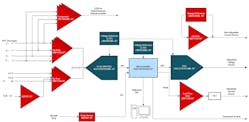Members can download this article in PDF format.
Radiation-hardened and radiation-tolerant products can help you develop mission-critical circuits with the high integration, power density, precision, accuracy, and bandwidth required for space applications. Choosing space-grade products for your designs ensures your circuits will have the reliability that enables them to operate for decades in the harsh environments of space.
Texas Instruments has a history in space applications dating back to 1958, when the U.S. Explorer 1 satellite carried into orbit radiation-detection circuitry incorporating the newly released TI 2N335 silicon-grown junction transistor. Subsequently, TI semiconductor devices have landed on the moon and assisted in exploring the planets. TI’s space-grade devices range from precision op amps to data converters and FPGAs.
Satellite-Monitoring Reference Design
Many space applications require the monitoring of temperature, voltage, and current parameters in multiple satellite subsystems. To address these requirements, Texas Instruments offers the TIDA-010197 satellite-health-monitoring and control-platform reference design for radiation-hardened satellite telemetry systems. The design utilizes the versatile LMP7704-SP to accurately monitor the parameters and provide feedback to a host board.
The reference design includes numerous subsystems, including a radiation-hardened MSP430FR5969-SP mixed-signal MCU for system control and data processing, an analog front end for signal conditioning, and system power-management and sequencing circuitry. The design can be configured with an external radiation-hardened, 8-channel, 50-kS/s to 1-MS/s, 12-bit SAR ADC (the ADC128S102QML-SP) for a 5-V full-scale range (see figure). Alternatively, it can use the 12-bit SAR ADC integrated into the MSP430FR5969-SP MCU for a more compact design with a 2.5-V full-scale range.
Analog inputs with 1% accuracy include 0 to 5 V, 0 to 20 V, 0 to 40 V, −5 to 5 V, 0.25 to 1 A, −2 to 2 A, and 0 to 500 mA. The design also features a TMP461-SP radiation-hardened, high-accuracy, low-power remote-temperature-sensor monitor with a built-in local temperature sensor. The reference design delivers three analog outputs: 0 to 10 V, 4 mA (fixed), and up to 4 mA (adjustable).
In addition to the space-grade op amps, MCU, temperature-sensor monitor, and ADC, the reference design makes use of the INA901-SP radiation-hardened, −15- to 65-V, split-stage current-sense amplifier with in-line filter option, and the DAC121S101QML-SP 12-bit micropower DAC with rail-to-rail output.
JESD204 Interface
Also applicable to space applications is the Joint Electron Device Engineering Council’s JESD204 standard, which defines a serial interface between data converters (ADCs and DACs) and logic devices (FPGAs or ASICs) for use in high-density systems. The standard grew out of the need to serialize data-converter digital data and reduce the number of interconnects between mixed-signal devices and processing elements. JESD204 technology uses encoding for SerDes synchronization, clock recovery, and dc balance.
The new JESD204C revision of the standard offers many enhancements to the A and B versions while maintaining backward compatibility with some limitations. Many of the enhancements improve coding efficiency and overall throughput—up to 32 Gb/s versus up to 12.5 Gb/s for revision B. One notable change is the addition of denser, more efficient 64B/66B and 64B/80B coding schemes; 64B/66B has only a 3.125% coding overhead versus the 20% overhead for the 8B/10B scheme used in revision B. One tradeoff is a certain coding latency associated with the more efficient coding schemes. Revision C retains support for 8B/10B.
Texas Instruments offers many JESD-approved products, including the ADC12DJ3200QML-SP 12-bit, dual 3.2-GSps or single 6.4-GSps, RF-sampling ADC for aerospace applications. The ADC12DJ3200QML-SP can serve in a range of space-based applications, including wideband satellite communications and synthetic aperture radar (SAR). The wide input bandwidth enables direct RF sampling to at least 8 GHz, and the high sampling rate allows for signal bandwidths of greater than 2 GHz.
In addition, Texas Instruments offers JESD204 rapid-design IP, which gives FPGA engineers the opportunity to quickly achieve a working JESD204 system. The IP architecture isolates downstream digital processing and other application logic from most of the performance- and timing-critical constraints of the JESD204 protocol. The IP helps cut firmware development time and ease FPGA integration. It supports a variety of FPGA families, including the Xilinx Virtex UltraScale and UltraScale+, the Xilinx Kintex UltraScale and UltraScale+, and the Xilinx Zynq UltraScale+.
Conclusion
Resources extending from subcircuit examples to a satellite-health-monitoring reference design can help you engineer reliable systems for space-based applications. Texas Instruments is leveraging its decades of experience in space missions to provide engineering knowledge plus a full line of space-grade components from op amps to data converters as well as FPGAs and ASICs with JESD204-standardized serial interfaces.

